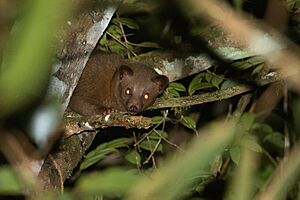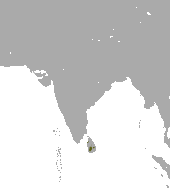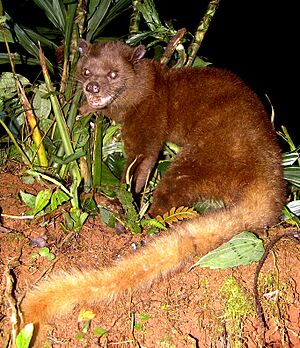Golden palm civet facts for kids
Quick facts for kids Golden palm civet |
|
|---|---|
 |
|
| Conservation status | |
| Scientific classification | |
| Genus: |
Paradoxurus
|
| Species: |
zeylonensis
|
 |
|
| Golden palm civet range | |
| Synonyms | |
The golden palm civet (Paradoxurus zeylonensis) is a small, cat-like animal. It belongs to the viverrid family. This animal lives only in Sri Lanka, which means it is endemic to that island.
Sadly, the golden palm civet is listed as a Vulnerable animal. This means its numbers are decreasing. The places where it lives in Sri Lanka's hills are getting smaller and less healthy.
The golden palm civet was first described by a scientist named Peter Simon Pallas in 1778.
Contents
What is a Golden Palm Civet?
The golden palm civet has fur that can be gold to golden brown on its back. Its belly is usually a lighter gold color. Some civets are dark brown, while others are more reddish or rusty. The tips of their hairs often look shiny.
Their legs are usually the same color as their body. But their tail and face can sometimes be lighter, like a pale gray. Their face doesn't have any special patterns. The long whiskers on their face, called vibrissae, are a dirty white color.
The hair on their shoulders grows in a special way. It swirls from two spots and grows forward along their neck and head. Hair on their throat also grows forward from one swirl. On their back, you might see faint stripes and spots. These marks are a little darker than their main fur color.
Golden palm civets can look different depending on where they live. Those from the mountains are often darker. They might be a grayish-brown color. Their belly is usually lighter, and the tip of their tail can be yellowish-white.
Their ears are rounded and have no hair on the edges. Their eyes are big, and their pupils (the dark center of the eye) are shaped like a vertical line. This civet can also make a pleasant smell from special glands. It smells a bit like Michelia champaca flowers.
Where Do Golden Palm Civets Live?
The golden palm civet lives in different types of forests in Sri Lanka. It can be found in lowland rain forests. It also lives in mountain evergreen forests. Sometimes, it lives in thick monsoon forests too.
How Do Golden Palm Civets Live?
Golden palm civets really need forests to survive. They can handle some small changes to their home. But they need parts of the forest to stay connected.
These civets spend most of their time in trees. They are active at night, which means they are nocturnal. They usually live alone. Their diet includes many different things. They eat fruits, berries, and small creatures without backbones, like invertebrates. They also eat a variety of small animals with backbones, called vertebrates.
Golden Palm Civets in Sri Lankan Culture
In Sri Lanka, people have different names for the golden palm civet. In the Sinhala language, it's called pani uguduwa පැනි උගුඩුවා. Other names are sapumal kalawaddha සපුමල් කලවැද්දා or ranhothambuwa රන් හොතබුවා / hotambuwa හොතබුවා.
Sometimes, both golden palm civets and Asian palm civets are called kalawedda in Sinhala. In the Tamil language, they might be called maranai (மரநாய்).
However, the word hotambuwa is often used for a different animal. It's sometimes used for the ruddy mongoose (Herpestes smithii). This is because the civet and the mongoose can look similar in color and appearance. So, people sometimes confuse them.
The golden palm civet has even appeared on a 3-rupee postal stamp in Sri Lanka. But on the stamp, it was called "Golden Palm Cat."



